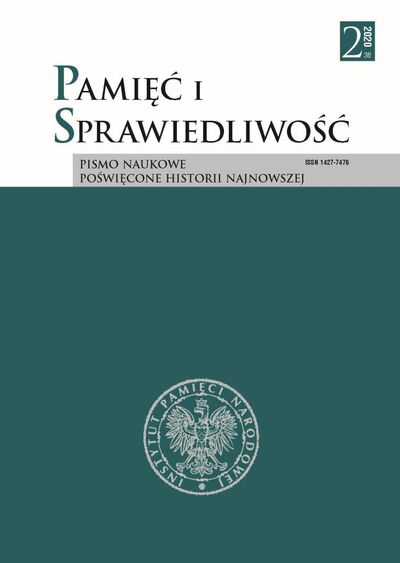The Economic Policy of the Hungarian Communist Party between 1945 and 1946
Pamięć i Sprawiedliwość, Vol. 36 No 2 (2020), pages: 52-69
Publication date: 2020-12-31
 https://doi.org/10.48261/PIS203604
https://doi.org/10.48261/PIS203604
Résumé
With the careful examination of available postwar documents of the Communist Party, this paper aims to present the measures taken by the Hungarian Communist Party in 1945 and 1946 to influence Hungary’s economic policy. In the aforementioned period, the Hungarian Communists devised long-term plans for a gradual takeover of political power in Hungary while enjoying the support of the Soviets. The Hungarian Communist leadership tried to create an economic policy that would make the Party itself an integral factor in the stabilization process and thus secure its place in the highest echelons of political power in Hungary. From the beginning, the MKP’s highest priorities were to acquire key political positions and to weaken and disintegrate existing social and political structures. In order to execute this plan, the Hungarian Communist Party created various “instruments” such as the Supreme Economic Council, which was secretly co-ordinated by the State Policy Department of the Hungarian Communist Party.
Références
Magyar Nemzeti Levéltár Országos Levéltára (National Archives of Hungary)
Politikatörténeti- és Szakszervezeti Levéltár (Archives of the Institute of Political History and Trade Unions)
A Magyar Kommunista Párt és a Szociáldemokrata Párt határozatai 1944–1948 [Resolutions of the Hungarian Communist Party and the Social Democratic Party, 1944–1948], ed. S. Rákosi, B. Szabó (Budapest: Kossuth, 1979).
Iratok a magyar-szovjet kapcsolatok történetéhez. 1944. október – 1948. június. Dokumentumok [Papers for the History of the Hungarian-Soviet Relations. October 1944 – June 1948. Documents], ed. I. Vida (Budapest: Gondolat, 2005).
Pártközi értekezletek. Politikai érdekegyeztetés, politikai konfrontáció 1944–1948 [Inter-party Sessions: Reconciliation of Political Interests and Political Confrontations, 1944–1948], ed. J. Horváth, É. Szabó, L. Szűcs and K. Zalai (Budapest: Napvilág, 2003).
Baráth M., A Kreml árnyékában. Tanulmányok Magyarország és a Szovjetunió kapcsolatainak történetéhez [In the Shadow of the Kremlin: Studies on the History of Relations between Hungary and the Soviet Union] (Budapest: Gondolat, 2014).
Baráth M., Gerő Ernő politikai pályája 1944–1956 [The Political Career of Ernő Gerő, 1944–1956] (Eötvös Lóránd University, 1997).
Borhi L., Hungary in the Cold War 1945–1956: Between the United States and the Soviet Union (Budapest: Central University Press, 2004).
Botos J., “A pengő megsemmisülése, a forint születése, 1938–1946” [The Destruction of the Pengő and the Birth of the Forint, 1938–1946], Múltunk 1 (2016).
Djilas M., Conversations with Stalin (New York: Harcout, Brace & World, 1962).
Germuska P., “Adalékok a magyarországi gazdasági intézményrendszer 1945–1948 közötti változásaihoz” [Supplements to the Economic Institutional System Change in Hungary between 1945 and 1948] [in:] Lépések a gazdasági teljhatalom felé 1945–1948 [Steps towards Absolute Economic Power, 1945–1948], ed. B. Bank, P. Germuska (Budapest: Nemzeti Emlékezet Bizottsága, 2017).
Gyarmati G., A Rákosi-korszak: Rendszerváltó fordulatok évtizede Magyarországon, 1945–1956 [The Rákosi Era: Decade of Change of Regime in Hungary] (Budapest: ÁBTL & Rubicon, 2013).
Korom M., “A moszkvai magyar kommunista emigráció 1944. őszi megbeszélései a programkészítésről” [Discussions of the Hungarian Communist Emigration in Moscow in the Fall of 1944 on the Preparation of a Policy Program], Múltunk 1 (1993).
Kramer M., “Stalin, Soviet Policy, and the Establishment of a Communist Bloc in Europe, 1941–1949” [in:] Imposing, Maintaining, and Tearing Open the Iron Curtain: the Cold War and East Central Europe, 1945–1989, ed. M. Kramer, V. Smetana (Lanham (Md): Rowman & Littlefield, 2014).
Majoros K., “A múlt század jeles magyar közgazdásza: Varga István (1897–1962)” [A Famous Hungarian Economist of the Last Century: István Varga (1897–1962)], KTK/IE Műhelytanulmányok 9 (2003).
Mark E., “Revolution by Degrees, Stalin’s National-Front Strategy for Europe, 1941–1947”, CWIHP 31 (2001).
Rákosi M., “Harcolunk a demokráciáért – egyetlen lépést sem teszünk visszafelé” [We Fight for Democracy – Not One Step Backwards] Szabad Nép (19 II 1946).
Rákosi M., Visszaemlékezések 1940–1956 [Recollections 1940–1956] (Budapest: Napvilág, 1997).
Rákosi S., Az MKP és az MDP szervezeti felépítése, 1944–1956 [The Organizational Structure of the Hungarian Communist Party and the Hungarian Workers’ Party, 1944–1956] (Budapest: MSZMP Párttörténeti Intézete, 1964).
Varga J., A földreform és a közélet demokratizálása [Land Reform and the Democratization of Public Life] (Budapest: Magyar-Szovjet Kulturális Társaság, 1945).
Licence
(c) Tous droits réservés Pamięć i Sprawiedliwość 2023

Ce travail est disponible sous licence Creative Commons Attribution - Pas d'Utilisation Commerciale - Pas de Modification 4.0 International.
 Język Polski
Język Polski
 English
English
 Deutsch
Deutsch
 Français (France)
Français (France)
 Italiano
Italiano
 Русский
Русский


 PDF (English)
PDF (English)




